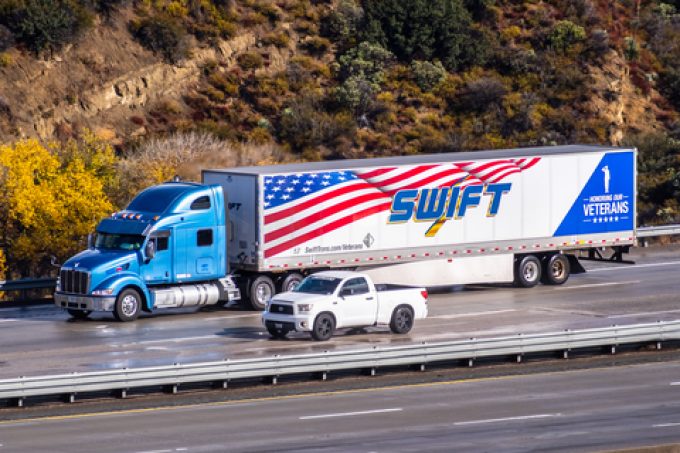'The Great Transport Value Play'
Where the wind blows
TFII: SOLID AS USUALMAERSK: WEAKENINGF: FALLING OFF A CLIFFAAPL: 'BOTTLENECK IN MAINLAND CHINA'AAPL: CHINA TRENDSDHL: GROWTH CAPEXR: ANOTHER SOLID DELIVERYMFT: HERE COMES THE FALLDSV: LOOK AT SCHENKER PERFORMANCEUPS: A WAVE OF DOWNGRADES DSV: BARGAIN BINKNX: EARNINGS OUTODFL: RISING AND FALLING AND THEN RISING
TFII: SOLID AS USUALMAERSK: WEAKENINGF: FALLING OFF A CLIFFAAPL: 'BOTTLENECK IN MAINLAND CHINA'AAPL: CHINA TRENDSDHL: GROWTH CAPEXR: ANOTHER SOLID DELIVERYMFT: HERE COMES THE FALLDSV: LOOK AT SCHENKER PERFORMANCEUPS: A WAVE OF DOWNGRADES DSV: BARGAIN BINKNX: EARNINGS OUTODFL: RISING AND FALLING AND THEN RISING

On the heels of a disappointing Q4 that pushed it behind earnings targets, Knight-Swift, the largest of the US truckload carriers, intends to expand through an acquisition in the LTL sector, while expecting a challenging first half for its core segment.
Shipments by truck in the fourth quarter suffered their largest drop since the height of the pandemic, according to the US Bank Freight Payment Index.
While Knight-Swift Transportation’s management had braced for a subdued spot market and infrequent project activity, general freight demand turned out to be “significantly worse than anticipated”, revealed CFO David Miller in the earnings call following the results announcement, on 23 January.
This demand slump drove a 41% drop in operating income, compared with the fourth quarter of 2021.
US Bank data shows US trucking volumes in Q4 22 down 7.1% year on year – a magnitude of decline not seen since the third quarter of 2020. The shipment count in Q3 22 was 4.6% down on Q3 21.
Both the For-Hire Truck Tonnage Index of American Trucking Associations (ATA) and the Cass Freight Shipments Index showed consecutive declines from September through December.
“A pullback in consumer spending is causing the truck freight market to soften,” said ATA SVP and chief economist Bob Costello. “At the same time, monetary policy changes are reducing demand for large-ticket items in interest rate-sensitive areas like autos and homes.”
Knight-Swift president and CEO David Jackson blamed the slowdown largely on moves by importers to bring in goods early to avoid supply chain snare-ups, and does not expect the coming months to be much better.
“Last year, we expected the first half to be strong and then cool off in the second half, which is largely what happened,” said Mr Miller. “This year, we expect the opposite – more challenging environments in the first half, before we start to see a recovery to a more typical freight demand, leading to an improving Q4 peak season.”
Indeed, Mr Costello has predicted a possible mild recession in the early stages of 2023, followed by a “moderate” recovery.
In some areas the outlook is bleaker than in others. US Bank’s numbers for the fourth quarter show considerable regional variation. In the south-western US, shipment volume actually increased 0.4% from the previous quarter, and 6.3% year on year, buoyed by energy production, flourishing US-Mexico trade and elevated seaport activity. At the opposite end of the spectrum, in the west, shipments were down 10.6% from the third quarter, and 8.9% year on year, reflecting the drop in imports flowing through west coast ports. Other regions also registered sequential declines in traffic, ranging from 1.4% in the south-east to 6% in the midwest.
As it grinds through a challenging market, Knight-Swift is looking to lift its fortunes through expansion in the LTL sector, which fared considerably better than its other segments. The firm’s Q4 operating income in LTL surged 87% year on year, to $25.6m, while it slumped elsewhere, led by a 37% drop in the truckload business.
Mr Jackson did not rule out an acquisition in the truckload business, but his focus is on a takeover of an LTL player. Management has indicated it would like to build up a US-wide LTL footprint in the long run, having entered the sector in 2021 with a couple of takeovers.
“Our number-one priority clearly is LTL,” Mr Jackson told investors and industry analysts.
LTL operators have fared much better over the past year than truckload carriers, as capacity remained relatively tight allowing them to hold the line on pricing. Nevertheless, this market also softened in the fourth quarter. Old Dominion recently reported an 8.6% annual decline in daily shipments for the period, while its tonnage shrank 9.1%.
However, volumes in January were stronger than in December, noted CFO Adam Satterfield in its earnings call, adding that volume was expected to pick up again in the spring. He said: “We’re starting to trend back in the right direction. We expect to see increases starting in March and continuing through the second quarter.”
Truckload carriers would love to be able to pronounce similar expectations, but for them, light at the end of the tunnel appears to be just a glimmer, further down the road.
Comment on this article